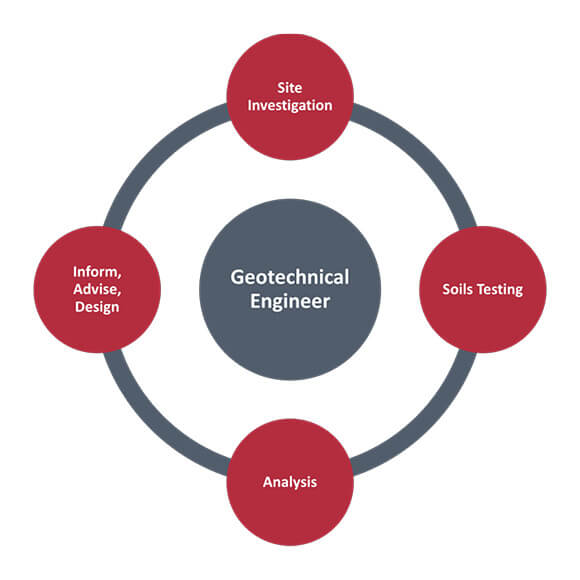7 Simple Techniques For Geotheta
7 Simple Techniques For Geotheta
Blog Article
The Geotheta Statements
Table of ContentsNot known Factual Statements About Geotheta The Single Strategy To Use For GeothetaNot known Factual Statements About Geotheta Rumored Buzz on GeothetaNot known Incorrect Statements About Geotheta

They perform site investigations, gather examples, carry out lab examinations, and analyze data to examine the viability of the ground for construction jobs - Geo Tech Engineering. Based upon their searchings for, geotechnical designers provide suggestions for structure layout, incline security, maintaining frameworks, and mitigation of geotechnical dangers. They team up with other professionals, such as architects, structural designers, and building and construction teams, to guarantee that geotechnical factors to consider are incorporated right into the total task design and implementation
By evaluating the actions and properties of soil and rock, they can determine potential geotechnical hazards such as landslides, dirt negotiation, or slope instability. Their expertise aids protect against failings or crashes that could threaten lives and building. Here are some detailed tasks and duties of a geotechnical engineer: Website Investigation: Geotechnical designers conduct website examinations to gather data on subsurface problems.
They analyze the data to understand the homes and actions of the soil and rock, including their toughness, permeability, compaction attributes, and groundwater problems. Geotechnical Evaluation and Design: Geotechnical engineers assess the data collected throughout website examinations to evaluate the stability and suitability of the site for building projects. They do geotechnical computations and modeling to assess aspects such as birthing capability, negotiation, slope stability, lateral earth stress, and groundwater flow.
The Basic Principles Of Geotheta
Foundation Style: Geotechnical designers play a critical duty in developing structures that can securely support the intended framework. They evaluate the soil problems and tons requirements to determine the suitable structure kind, such as superficial foundations (e.g., grounds), deep structures (e.g (https://filesharingtalk.com/members/599923-geotheta)., piles), or specialized strategies like dirt enhancement. They take into consideration aspects such as settlement limits, birthing capability, and soil-structure communication to develop ideal structure layouts
They evaluate building and construction plans, monitor site tasks, and conduct field examinations to confirm that the style suggestions are complied with. If unforeseen geotechnical issues develop, they assess the circumstance and supply recommendations for remediation or changes to the style. Threat Assessment and Mitigation: Geotechnical engineers evaluate geotechnical dangers and threats connected with the project website, such as landslides, liquefaction, or soil disintegration.

Cooperation and Communication: Geotechnical designers function carefully with other professionals associated with a task, such as architects, structural engineers, and building groups. Reliable communication and partnership are vital to integrate geotechnical considerations into the total project layout and building procedure. Geotechnical engineers provide technological proficiency, response queries, and guarantee that geotechnical requirements are fulfilled.
Indicators on Geotheta You Should Know
Below are some sorts of geotechnical engineers: Foundation Engineer: Foundation designers focus on creating and assessing structures for frameworks. They analyze the soil conditions, load demands, and site features to establish the most proper foundation type and design, such as shallow structures, deep structures, or specialized methods like stack structures.
They assess the elements influencing slope stability, such as soil homes, groundwater problems, and incline geometry, and establish approaches to avoid incline failings and alleviate threats. Earthquake Engineer: Quake engineers focus on assessing and developing frameworks to endure seismic pressures. They assess the seismic risk of a website, evaluate dirt liquefaction possibility, and establish seismic style criteria to ensure the safety and security and strength of structures throughout quakes.
They carry out area screening, gather samples, and examine the accumulated information to define the dirt homes, geologic developments, and groundwater conditions at a website. Geotechnical Instrumentation Designer: Geotechnical instrumentation designers concentrate on monitoring and measuring the actions of soil, rock, and frameworks. They set up and keep instrumentation systems that monitor variables such as soil negotiation, groundwater levels, incline activities, and structural displacements to assess efficiency and offer early cautions of prospective concerns.
Geotheta for Beginners
They conduct tests such as triaxial examinations, consolidation examinations, direct shear tests, and leaks in the structure tests to collect information for geotechnical analysis and style. Geosynthetics Designer: Geosynthetics engineers concentrate on the design and application of geosynthetic materials, such as geotextiles, geogrids, and geomembranes. They make use of these materials to improve soil security, enhance slopes, offer water drainage options, and control erosion.
They often tend to be investigative individuals, which implies they're intellectual, introspective, and investigative. They are curious, systematic, logical, analytical, and logical. A few of them are additionally social, meaning they're kind, generous, cooperative, individual, caring, helpful, empathetic, skillful, and pleasant. Does this seem like you? Take our complimentary occupation test to find out if geotechnical engineer is one of your top job suits.
In the workplace setting, geotechnical designers make use of specialized software program devices to execute estimations, produce designs, and analyze information. They prepare records, testimonial job specs, interact with customers and staff member, and coordinate job activities. The office setup supplies a conducive environment for research study, analysis, and partnership with various other experts associated with the project.
Getting The Geotheta To Work
They often see job sites to carry out site investigations, assess geotechnical problems, and collect data for evaluation. These check outs involve taking a trip to various places, in some cases in remote or tough terrains. Geotechnical designers might do dirt sampling, conduct examinations, and monitor building tasks to make sure that the geotechnical aspects of the project are being implemented appropriately.
Geotechnical designers additionally function in specialized geotechnical research laboratories. Geotechnical laboratory designers function extensively in these environments, dealing with testing equipment, operating tools, and recording information.
Report this page